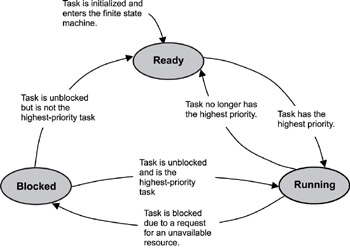Книга: Real-Time Concepts for Embedded Systems
5.3 Task States and Scheduling
Whether it's a system task or an application task, at any time each task exists in one of a small number of states, including ready, running, or blocked. As the real-time embedded system runs, each task moves from one state to another, according to the logic of a simple finite state machine (FSM). Figure 5.2 illustrates a typical FSM for task execution states, with brief descriptions of state transitions.

Figure 5.2: A typical finite state machine for task execution states.
Although kernels can define task-state groupings differently, generally three main states are used in most typical preemptive-scheduling kernels, including:
· ready state - the task is ready to run but cannot because a higher priority task is executing.
· blocked state - the task has requested a resource that is not available, has requested to wait until some event occurs, or has delayed itself for some duration.
· running state - the task is the highest priority task and is running.
Note some commercial kernels, such as the VxWorks kernel, define other, more granular states, such as suspended, pended, and delayed. In this case, pended and delayed are actually sub-states of the blocked state. A pended task is waiting for a resource that it needs to be freed; a delayed task is waiting for a timing delay to end. The suspended state exists for debugging purposes. For more detailed information on the way a particular RTOS kernel implements its FSM for each task, refer to the kernel's user manual.
Regardless of how a kernel implements a task's FSM, it must maintain the current state of all tasks in a running system. As calls are made into the kernel by executing tasks, the kernel's scheduler first determines which tasks need to change states and then makes those changes.
In some cases, the kernel changes the states of some tasks, but no context switching occurs because the state of the highest priority task is unaffected. In other cases, however, these state changes result in a context switch because the former highest priority task either gets blocked or is no longer the highest priority task. When this process happens, the former running task is put into the blocked or ready state, and the new highest priority task starts to execute.
The following describe the ready, running, and blocked states in more detail. These descriptions are based on a single-processor system and a kernel using a priority-based preemptive scheduling algorithm.
- Разработка приложений баз данных InterBase на Borland Delphi
- Open Source Insight and Discussion
- Introduction to Microprocessors and Microcontrollers
- Chapter 6. Traversing of tables and chains
- Chapter 8. Saving and restoring large rule-sets
- Chapter 11. Iptables targets and jumps
- Chapter 5 Installing and Configuring VirtualCenter 2.0
- Chapter 16. Commercial products based on Linux, iptables and netfilter
- Appendix A. Detailed explanations of special commands
- Appendix B. Common problems and questions
- Appendix E. Other resources and links
- IP filtering terms and expressions




